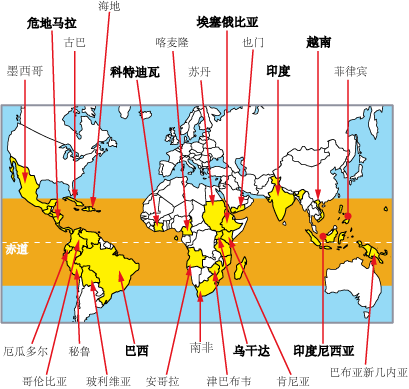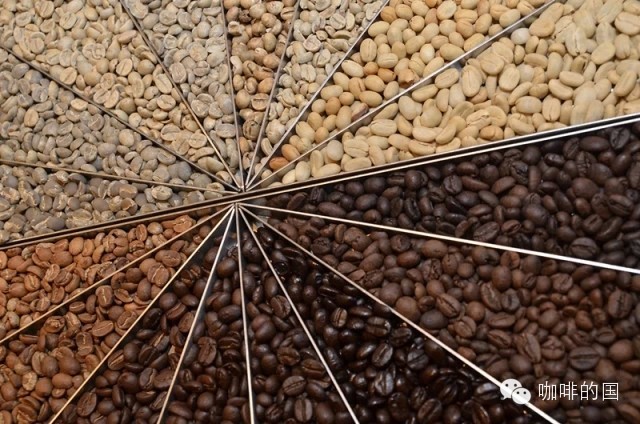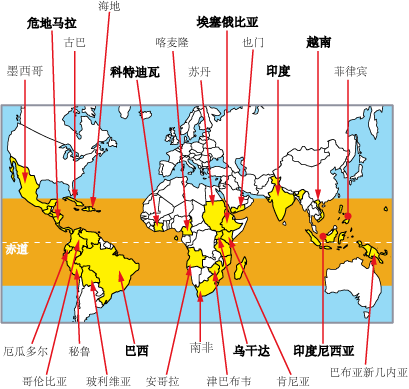Coffee treasures from the hometown of the giant tortoise in the equatorial coffee producing area, St. Cristobal in the Galapagos Islands.
Galapagos Islands
Coffee treasures from the hometown of giant turtles, which are of excellent quality and do not use any chemicals when growing.
Coffee is grown in San Cristobal (SaintCrst ó bal). St. Cristobal is a larger island in the Galapagos Islands (GalapagosIslands) and the only one in the archipelago with plenty of fresh water. At an altitude of 410m, there is a small lake called El.Junco, which forms streams along the rocks and volcanic rocks on the southern slope of the island, and mineral-rich fresh water moistens the land of St. Cristobal, keeping the soil moist and fertile.
In 1875, Ecuadorian Aboriginal J. Cobos planted about 100 hectares of Arabian bourbon coffee trees at the Hasunda Coffee Garden (HaciendaElCafetal) in San Cristobal. The elevation of the plantation is between 140m and 275m, and the climate in this area is equivalent to that of 910m to 1830 m inland. This gradient is suitable for the growth of high acidity extra hard coffee beans (SHB) and is the key to the high quality of coffee.
As the world coffee industry is moving towards a targeted mass production model, a small and uncertain coffee industry like St. Cristobal is in trouble and may eventually be forced to give up without profit.
In the early 1990s, however, the Gonzalez family bought Hasunda Coffee Park. The localized microclimate caused by the Humboldt current (HumboldtCurrent), strong equatorial sunlight and sharp temperature changes (43 ℃ at sea level and 10: 16 ℃ at 275m above sea level) provided unique advantages that prompted the Gonzalez family to expand their coffee plantation.
Since then, the area of the coffee plantation has doubled through the reclamation of early land. Because of the unique role of the Galapagos Islands in the course of history, the Government of Ecuador has designated the Galapagos Islands as a national park and no longer allows the land to be reclaimed as new agricultural land. and the introduction and use of chemical fertilizers, pesticides, herbicides and other chemicals are strictly prohibited, so coffee in the Galapagos Islands is recognized as a natural product.

Important Notice :
前街咖啡 FrontStreet Coffee has moved to new addredd:
FrontStreet Coffee Address: 315,Donghua East Road,GuangZhou
Tel:020 38364473
- Prev

Coffee powder how to preserve coffee powder how to preserve coffee powder is the best
In recent years, great changes have taken place in the coffee industry. The original mode of selling coffee beans has been changed to selling coffee powder, because this is relatively simple and convenient, many families do not have bean grinders, and different coffees need to be extracted with different curry utensils. It is more necessary for merchants to tell what kind of coffee utensils to use to make coffee when buying. Although coffee powder is more convenient, it is relatively
- Next

Latin American coffee the most distinctive manor coffee comes from the oil-rich country Neri
Venezuela's distinctive manor coffee comes from this oil-rich country. Oil was once considered to be the main export of Venezuela. Although coffee trees were introduced from Martinique in 1730 and Venezuela, coffee production was almost abandoned at the height of the oil industry. Recently, the coffee plantation has begun to recover, and the original Tippica (T
Related
- Guji coffee producing area of Guji, Ethiopia: Humbela, Shakiso, Wulaga
- What is the most expensive variety of Qiloso in BOP multi-variety group?
- How to store the coffee beans bought home?
- Why are Yemeni coffee beans so rare now?
- Ethiopian Sidamo all Red Fruit Sun Sun Santa Vini Coffee beans
- SOE is mostly sour? What does it mean? Is it a single bean? what's the difference between it and Italian blending?
- Is Italian coffee beans suitable for making hand-brewed coffee?
- How to choose coffee beans when making cold coffee? What kind of coffee beans are suitable for making cold coffee?
- Just entered the pit to make coffee, what kind of coffee beans should be chosen?
- Can only Japan buy real Blue Mountain Coffee? What are authentic Jamaican Blue Mountain coffee beans?

